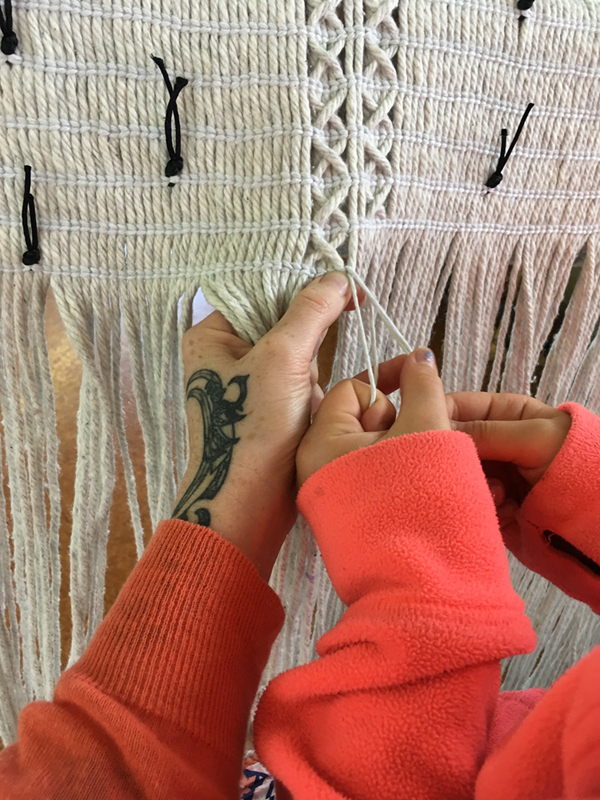Stitchery Me, Stitchery Do
DOI:
https://doi.org/10.18432/ari29434Keywords:
autoethnography, quilting, culturally responsive practice, identity, craftAbstract
While seeking to understand teachers’ philosophy on culturally responsive practice in the classroom, I used quilt-making to physically manifest my own story and those of my participants as method in an autoethnographic project. The craft of quilt-making became a metaphor for my past, yet spoke so much of my present and my future and provided something tangible with which we could all connect. Through the crafting and construction of the quilt I was able to explore and connect my experiences with those of my participants, our beliefs and personal philosophies of being Pākehā̄ (descendant of settler ancestors) teachers in secondary classrooms. The craft and autoethnography were in response to the project yet they speak louder than the project itself.
References
Adamson, G. (2008). When craft gets sloppy. Crafts 211, 36-40.
Berryman, M. (2008). Repositioning within indigenous discourses of transformation and self-determination (Doctoral thesis). University of Waikato, Hamilton, NZ. Retrieved from https://researchcommons.waikato.ac.nz/handle/10289/2565
Bishop, R., Berryman, M., Cavanagh, T., & Teddy, L. (2007). Te Kotahitanga phase 3 whānaungatanga: Establishing a culturally responsive pedagogy of relations in mainstream secondary school classrooms. Ministry of Education, NZ. Retrieved from http://www.educationcounts.govt.nz/__data/assets/pdf_file/0004/9922/Te_Kotahitanga_Phase3.pdf
Brien, J. (2017). Stitching lives together: Developing an understanding of Pākehā teachers' practice, pedagogy and philosophy in culturally responsive secondary classrooms (Master’s. thesis). University of Auckland, NZ. Retrieved from https://researchspace.auckland.ac.nz/handle/2292/32594
Chang, H., Ngunjiri, F. W., & Hernandez, K. C. (2012). Collaborative autoethnography. Walnut Creek, CA: Sage.
Cory, P., & McKelvey, S. (1995). The signature quilt: Traditions, techniques and the signature block collection. Saddle Brook, NJ: Quilt House.
Denzin, N. K. (2012). Afterword. Sport and neoliberalism. In D. Andrews & M. Silk (Eds.), Sport and neoliberalism (pp. 294-302). Philadelphia, PA: Temple Press.
Duffy, G. (1998). Teaching and balancing of round stones. Phi Delta Kappan, 79(10), 777-780.
Eddy, C. (2005). Quilted planet. London, UK: Octopus.
Fitzpatrick, E., & Bell, A. (2016). Summoning up the ghost with needle and thread. Departures in Critical Qualitative Research. 5(2), 1-24. Retrieved from https://researchspace.auckland.ac.nz/handle/2292/29396
Freeman, J. (1983). Quilting patchwork and applique 1700-1982: Sewing as a woman’s art. London, UK: Crafts Council.
Golding, W. (1959). Free fall. London, UK: Faber & Faber.
Horton, L. (2005). Mary Black’s family quilts: Memory and meaning in everyday life. Columbia,SC: University of South Carolina Press.
Jasso, A. & Jasso, R. (1995). Critical pedagogy: Not a method, but a way of life. In J. Frederickson (Ed.), Reclaiming our voices: Bilingual education, critical pedagogy and praxis (pp. 253-259). Ontario, CA: California Association for Bilingual Education.
Koelsch, L. E. (2012). The virtual patchwork quilt: A qualitative feminist research method. Qualitative Inquiry, 18(823), 823-829. Retrieved from http://dx.doi.org/10.1177/1077800412456957
Lapadat, J.C. (2017). Ethics in autoethnography and collaborative autoethnography. Qualitative Inquiry, 23(8), 589-603. Retrieved from https://journals.sagepub.com/doi/10.1177/1077800417704462
Lipsett, L. (1985). Remember me. San Francisco, CA: The Quilt Digest Press.
Metge, J. (1984). Learning and teaching: He Tikanga Māori. Wellington, NZ: Department of Education.
Mitchell, S. N., Reilly, R. C., & Logue, M. E. (2009). Benefits of collaborative action research for the beginning teacher. Teaching and Teacher Education, 25(2), 344-349.
Moya-Raggio, E. (1984). Arpilleras: Chilean culture of resistance. Feminist Studies, 10(2), 277-290.
Pelias, R. (2004). A methodology of the heart. Walnut Creek, CA: Alta Mira Press.
Quilting in America. (2009). Quilt blocks: Piece by piece. Retrieved from https://www.quilting-in-america.com/quilt-blocks.html
Shiner, L. (2012). ‘‘Blurred Boundaries’’? Rethinking the concept of craft and its relation to art and design. Philosophy Compass 7(4), 230-244.
Tobin, J., & Dobard, R. (2000). Hidden in plain view: A secret story of quilts and the underground railroad. New York, NY: Random House.
Wink, J. (2005). Critical pedagogy: Notes from the real world (3rd ed.). Boston, MA: Pearson/Ally & Bacon.
Published
How to Cite
Issue
Section
License
Copyright (c) 2019 Art/Research International: A Transdisciplinary Journal

This work is licensed under a Creative Commons Attribution-NonCommercial-NoDerivatives 4.0 International License.
Authors who publish with Art/Research International agree to the following terms:
a. Authors retain copyright and grant the journal right of first publication and the right to sublicense the Contribution, in the form in which it is published by the journal, to others under the terms and conditions of the of the Creative Commons Attribution-NonCommercial-NoDerivs (CC BY-NC-ND) that allows others to download the work and share the work with others with an acknowledgement of the work's authorship and initial publication in this journal, but they cannot change the work in any way or use any part of the work commercially.
b. Authors are able to enter into separate, additional contractual arrangements for the non-exclusive public distribution and display of the journal's published version of the work (e.g., post it to an institutional repository or publish it in a book), with an acknowledgement of its initial publication in this journal.
c. Authors are permitted and encouraged to post their work online (e.g., in institutional repositories or on their website) prior to and during the submission process, as it can lead to productive exchanges, as well as earlier and greater citation of published work (See The Effect of Open Access).
d. Authors wishing to include items (such as images or other media, or any creative works of others whether previously published or not) must contact the original copyright holder to obtain explicit permission to publish these items in Art/Research International. Writing permission should include: the title(s) of any copyrighted work, original place of publication if applicable, and an acknowledgement of having read Art/Research International's copyright notice. Authors are responsible for obtaining this permission and keeping it in their own records for later verification.



